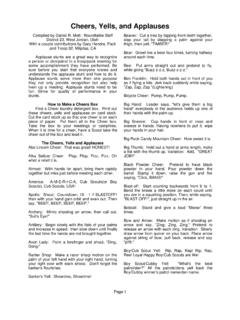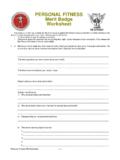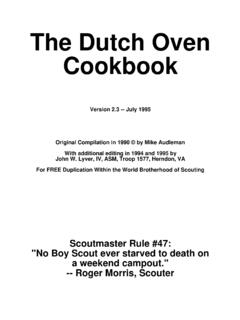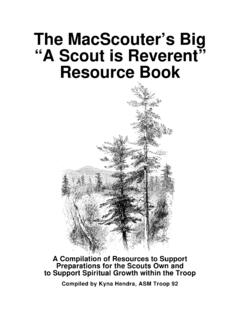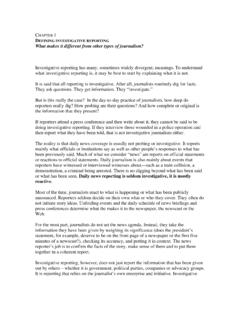Transcription of A Guide to Conducting Boards of Review - MacScouter
1 Guide to Conducting Boards of Review -- 1 -- Ray Klaus Amended by the USSSP A Guide to Conducting Boards of Review March 1995, Revised January 2000 Saddleback District, Orange County Council Boy Scouts of America Table of Contents Purpose of a board of Review Composition of a board of Review Mechanics of a board of Review Mechanics of a board of Review for Eagle Rank The Nature of the Questions What Every Scout Should Know Tenderfoot Rank 2nd Class Rank 1st Class Rank Star Rank Life Rank Eagle Rank Eagle Palms This document was originally written by Ray Klaus when he was District Advancement Chairman for Saddleback District, Orange County Council, BSA (1994-1995).
2 It was designed to assist units in Conducting Boards of Review . It is only a Guide ; units are encouraged to modify it as appropriate to their use. The procedures defined are, for the most part, typical for Saddleback District, Orange County Council, BSA as they were in 1995. The staff of the US Scouting Service Project, Inc. has modified the document slightly to incorporate their understanding of BSA Standards regarding Boards of Review . This document may be obtained via Internet, at the MacScouter Scouting Resources Online WWW site, at Guide to Conducting Boards of Review -- 2 -- Ray Klaus Amended by the USSSP Purpose of a board of Review : The members of a board of Review should have the following objectives in mind: To make sure the Scout has completed the requirements for the rank.
3 To see how good an experience the Scout is having in the unit. To encourage the Scout to progress further. Additionally, the board of Review provides "quality control" on advancement within the unit, it provides an opportunity for the Scout to develop and practice those skills needed in a interview situation, and it is an opportunity for the Scout to Review his accomplishments. The board of Review is NOT a retest; the Scout has already been tested on the skills and activities required for the rank. However, the chairman of the board of Review should ensure that all the requirements have been "signed off" in the Scout's handbook.
4 Additionally, the chairman should ensure that leadership and merit badge records are consistent with the requirements for the rank. The board of Review is an opportunity to Review of the Scout's attitudes, accomplishments and his acceptance of Scouting's ideals. Composition of a board of Review : For all ranks (except Eagle) and Eagle palms, the board of Review consists of three to six members of the Troop Committee. The Troop Advancement Chairperson typically acts as the chairperson of the board of Review . Relatives or guardians may not serve as members of a Scout's board of Review .
5 Unit leaders (Scoutmasters, Venturing Advisors, Team Coaches, Skippers, and their Assistants) also may not participate in a board of Review . For the rank of Eagle, the board of Review consists of three to six members drawn from Scouting and the community. At least one member of the District Advancement Committee must be a member of the board of Review for Eagle, and may serve as chairperson of the board of Review . Unit leaders from the Scout's unit, relatives, or guardians may not serve as members of a Scout's board of Review for Eagle.
6 A board of Review for Eagle may contain members of the community who are not registered Scouters; however, they should be knowledgeable of the principles of Scouting. For example, a representative from a chartering organization, an adult Eagle Scout (even if not currently registered), or a religious leader are frequently asked to assist with an Eagle board of Review . The Scout may request an individual to be a member of his board of Review , such as the Scout s Eagle councilor. Mechanics of a board of Review : The Scout is introduced to the board by the Chairperson of the board .
7 The Scout should be in full uniform (local or unit custom may dictate regarding neckerchief and badge sash). However, while preferred, a uniform is NOT mandatory The chairman of the board of Review should ask the Scout to come to attention, and recite one or more of the following: The Scout Law The Scout Oath The Scout Motto The Scout Slogan The Outdoor Code Guide to Conducting Boards of Review -- 3 -- Ray Klaus Amended by the USSSP For the lower ranks, one or two (usually the Law and Oath) should be sufficient. For higher ranks, more may be expected. One or two re-tries are appropriate, especially for younger Scouts, or if the Scout appears nervous.
8 The board members are invited to ask questions of the Scout (see the sections appropriate to each rank). The questions should be open-ended, offering an opportunity for the Scout to speak about his opinions, experiences, activities, and accomplishments. Avoid questions which only require a simple one or two word answer. If an answers is too brief, follow up with a, "Why?" or, "How can that be done?" to expand the answer. The questions need not be restricted to Scouting topics; questions regarding home, church, school, work, athletics, etc. are all appropriate.
9 The Chairperson should be made aware of any "out-of-bounds" areas; these should be communicated to the board before the board of Review begins ( , if a Scout is experiencing family difficulties due to a divorce, it would be prudent to avoid family issues.) The time for a board of Review should be from 15 to 30 minutes, with the shorter time for the lower ranks. When all members have had an opportunity to ask their questions, the Scout is excused from the room. The board members then consider whether the Scout is ready for the next rank; the board 's decision must be unanimous.
10 Once the decision is made, the Scout is invited back into the room, and the Chairperson informs the Scout of the board 's decision. If the Scout is approved for the next rank, there are general congratulations and hand shakes all around, and the Scout is encouraged to continue advancing. If there are issues which prevent the Scout from advancing to the next rank, the board must detail the precise nature of the deficiencies. The Scout must be told specifically what must be done in order to be successful at the next board of Review . Typically, an agreement is reached as to when the Scout may return for his subsequent board of Review .

